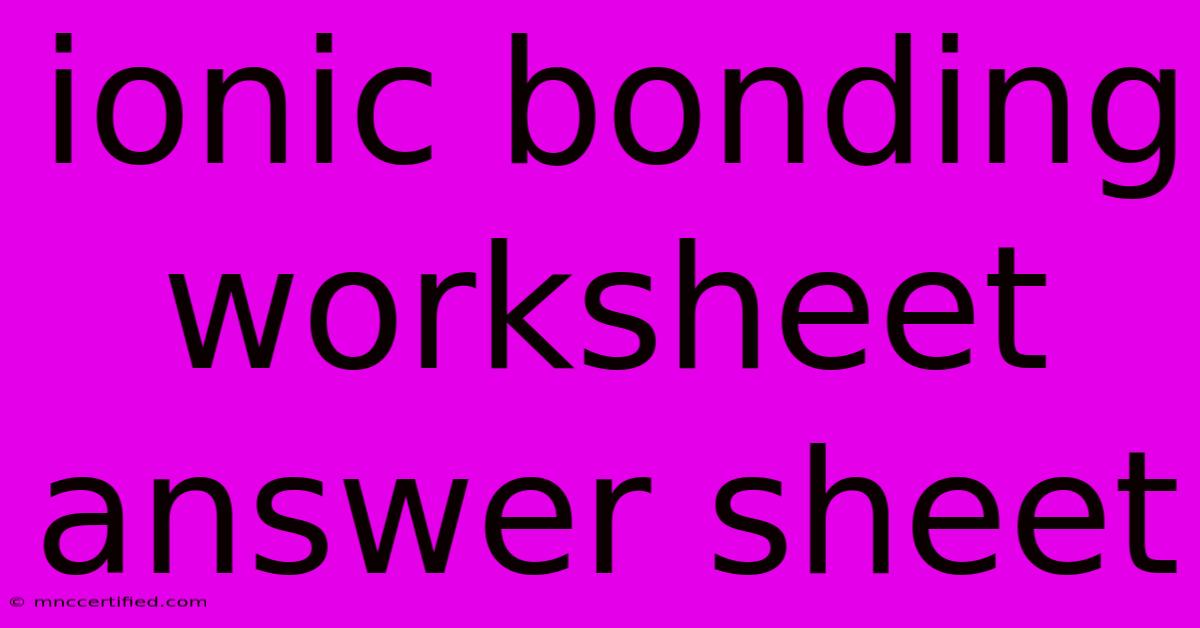Ionic Bonding Worksheet Answer Sheet

Table of Contents
Unlocking the Secrets of Ionic Bonding: A Comprehensive Worksheet Answer Key
Ionic bonding, a fundamental concept in chemistry, describes the electrostatic attraction between oppositely charged ions. Mastering this concept is crucial for understanding chemical reactions, predicting compound formation, and delving deeper into the world of chemical bonding.
This comprehensive guide provides detailed answers and explanations for a typical ionic bonding worksheet, empowering you to confidently navigate this key chemical concept.
Section 1: Identifying Ions
1. Define "ion."
An ion is an atom or molecule that has gained or lost one or more electrons, resulting in a net electrical charge.
2. What are the two types of ions?
- Cations: Positively charged ions formed by the loss of electrons.
- Anions: Negatively charged ions formed by the gain of electrons.
3. Write the symbol and charge for the following ions:
- Sodium: Na⁺
- Chlorine: Cl⁻
- Calcium: Ca²⁺
- Oxygen: O²⁻
- Aluminum: Al³⁺
- Nitrogen: N³⁻
4. Explain the difference between an ionic bond and a covalent bond.
- Ionic Bond: Formed by the electrostatic attraction between oppositely charged ions, typically involving a metal and a nonmetal.
- Covalent Bond: Formed by the sharing of electrons between two nonmetals.
Section 2: Writing Ionic Formulas
1. What are the rules for writing ionic formulas?
- Charge neutrality: The total positive charge must equal the total negative charge.
- Simplest whole-number ratio: The subscripts in the formula represent the smallest whole-number ratio of ions needed to achieve charge neutrality.
- Metals first: The metal cation is written first, followed by the nonmetal anion.
2. Write the formulas for the following ionic compounds:
- Sodium chloride: NaCl
- Calcium oxide: CaO
- Aluminum sulfide: Al₂S₃
- Magnesium fluoride: MgF₂
- Potassium bromide: KBr
3. Name the following ionic compounds:
- Li₂O: Lithium oxide
- BaCl₂: Barium chloride
- Fe₂O₃: Iron(III) oxide
- Cu₂S: Copper(I) sulfide
- SnO: Tin(II) oxide
4. Explain how to determine the charge of a transition metal ion in an ionic compound.
Transition metals can form multiple ions with different charges. To determine the charge, you need to consider the charge of the nonmetal ion and ensure charge neutrality in the compound. For example, in Fe₂O₃, the oxide ion (O²⁻) has a charge of -2, and there are three of them, resulting in a total negative charge of -6. Since there are two iron ions (Fe), each iron ion must have a charge of +3 to balance the charge.
Section 3: Understanding Properties of Ionic Compounds
1. List three properties of ionic compounds.
- High melting and boiling points: Due to the strong electrostatic forces between ions, a significant amount of energy is required to break these bonds.
- Crystalline structure: Ions arrange themselves in a highly ordered, repeating pattern to maximize electrostatic attraction.
- Solubility in water: Many ionic compounds dissolve in water, where the polar water molecules can interact with the charged ions and separate them.
2. Explain why ionic compounds conduct electricity when dissolved in water.
When ionic compounds dissolve in water, the ions become free to move. This movement of charged particles allows the solution to conduct electricity.
3. Why do ionic compounds not conduct electricity in the solid state?
In the solid state, the ions are fixed in a rigid lattice, unable to move freely. Therefore, no electric current can flow.
Section 4: Applying Your Knowledge
1. Predict the formula for the ionic compound formed between calcium and chlorine.
Calcium (Ca) forms a +2 ion (Ca²⁺), and chlorine (Cl) forms a -1 ion (Cl⁻). To achieve charge neutrality, we need two chloride ions for every calcium ion. The formula is therefore CaCl₂.
2. What is the name of the ionic compound formed between potassium and sulfur?
Potassium (K) forms a +1 ion (K⁺), and sulfur (S) forms a -2 ion (S²⁻). To achieve charge neutrality, we need two potassium ions for every sulfur ion. The formula is K₂S, and the name is potassium sulfide.
3. Explain why ionic bonding is essential for the formation of salts.
Salts are typically ionic compounds formed by the electrostatic attraction between a metal cation and a nonmetal anion. Ionic bonding is the primary force holding these ions together in the salt crystal lattice.
4. Describe the process of dissolving an ionic compound in water.
When an ionic compound dissolves in water, the polar water molecules surround the ions, weakening the electrostatic attraction between them. The water molecules essentially pull the ions apart, separating them into hydrated ions.
Conclusion
By working through this ionic bonding worksheet and its answer key, you've taken a significant step toward mastering this essential chemical concept. Remember, practice is key! Continue exploring the fascinating world of chemical bonding, and you'll discover the underlying principles that govern countless chemical reactions and shape the world around us.

Thank you for visiting our website wich cover about Ionic Bonding Worksheet Answer Sheet. We hope the information provided has been useful to you. Feel free to contact us if you have any questions or need further assistance. See you next time and dont miss to bookmark.
Featured Posts
-
York Insurance Services Workers Comp
Nov 11, 2024
-
Bowl Projections Update Alabama Now 3rd Seed
Nov 11, 2024
-
Is Laughing Gas Covered By Insurance
Nov 11, 2024
-
How To Collect On A Supersedeas Bond
Nov 11, 2024
-
Benson Boones Flip Fans React
Nov 11, 2024